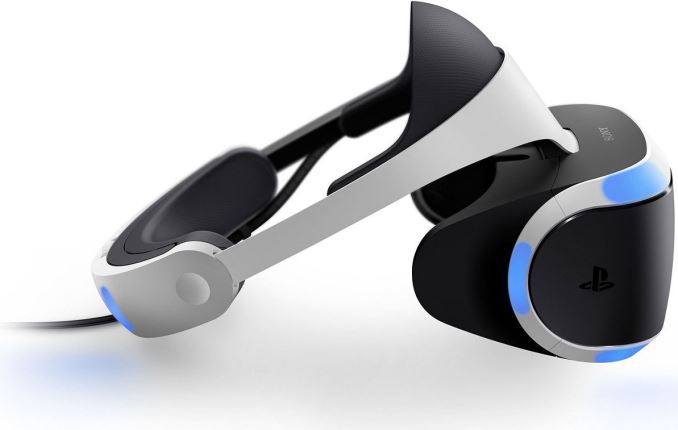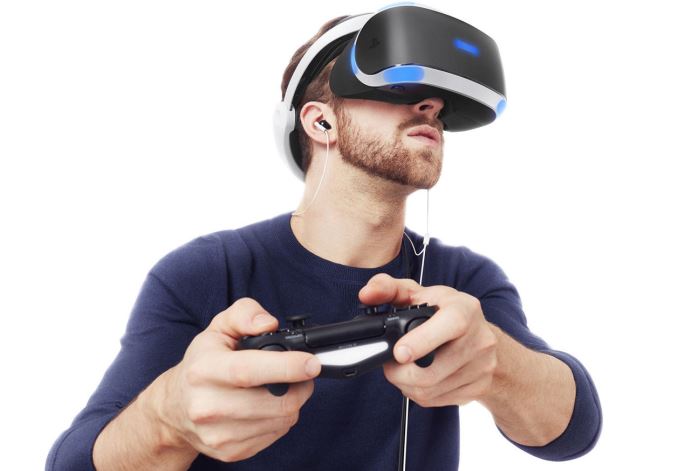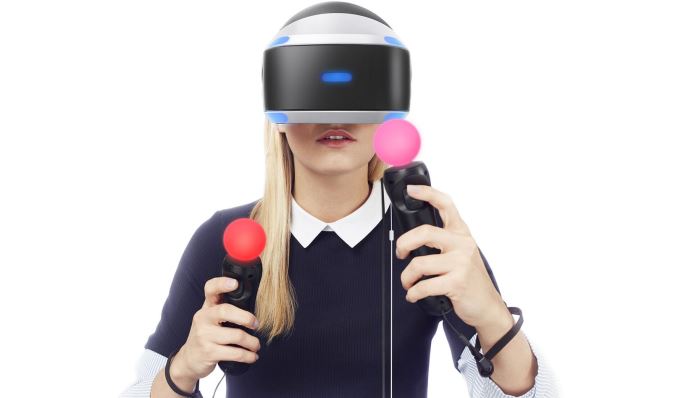Sony to Start Selling PlayStation VR in October for $399
by Anton Shilov on March 16, 2016 3:45 AM EST- Posted in
- Consoles
- PlayStation
- VR
- PlayStation VR
- GDC

Sony has published the price of its PlayStation VR virtual reality headset and confirmed its final specifications and launch timeframe on Tuesday. The company intends to start selling the unit in October for $399, which is slightly later than expected. While the product will be considerably more affordable than competing headsets from Oculus VR and HTC - though the sticker price does not include the required camera - its technical specs are somewhat behind its rivals.
| Specifications of VR Headsets | |||||
| Sony PlayStation VR | HTC Vive | Oculus Rift | |||
| Display | 5.7" OLED | 2x OLED | 2x OLED | ||
| Resolution | 1920x1080 960x1080 per eye |
2160x1200 1080x1200 per eye |
2160x1200 1080x1200 per eye |
||
| Refresh Rate | 90 Hz, 120 Hz | 90 Hz | 90 Hz | ||
| Sensors | three-axis gyroscope, three-axis accelerometer | over 70 sensors MEMS gyroscope, accelerometer |
6 degrees of freedom tracking 3-axis rotational tracking 3-axis positional tracking |
||
| Position Tracking | PlayStation Camera | Laser Vive Base Stations | Constellation system based on infrared sensors | ||
The Sony PlayStation VR head-mounted display (HMD) (CUH-ZVR1-series) features a 5.7” OLED display with 1920x1080 (960x1080 per eye) resolution, 90 Hz – 120 Hz refresh rate and approximately 100° field of view. The PS VR HMD is equipped with six-axis motion sensing system (three-axis gyroscope, three-axis accelerometer) as well as stereo headphones. Right now, Sony does not reveal many details about its VR headset, so, we do not know a lot of peculiarities of the HMD, such as display or motion to photon latencies. Nonetheless, based on what we do know about Sony’s VR headset, we can say that it uses a lot of custom-made components, which are optimized for virtual reality. Every PlayStation VR will come with a special processor unit, which will plug to the PlayStation 4 game console. Sony’s VR headset will connect to the processor unit using an HDMI cable, a PS4’AUX cable, as well as a stereo mini-jack.
Sony does not disclose what is inside the processor unit, but it claims that it does 3D audio processing as well as enables multi-display capabilities. In particular, the processor unit can enable cinematic mode, which lets users watch content or play games (including currently available PS4 titles) on a large virtual 225” screen. In addition, the processor unit can show what happens in virtual worlds on TV screens (in mirroring mode) as well as show different content on TV and VR screens (in separate mode). The processor comes in at a relatively light 365 grams, so while Sony isn't disclosing much about the internals, it's unlikely to contain much in the way of high-powered hardware; perhaps a semi-custom processor of some kind. The processor unit will use three HDMI ports, a USB port and an AUX cable to connect to a TV, a PS4 and a PS VR.
Each PlayStation VR headset will be bundled with the PlayRoom VR set of games by Sony Computer Entertainment Worldwide Studios. The PlayRoom VR suit will include six online virtual reality games.
Sony claims that 230 game developers and publishers are working on 160 various PS VR software titles and 50 of them will be available already this year. Sony claims that such games as Eagle Flight, EVE: Valkyrie, Headmaster, Rez Infinite, Wayward Sky, RIGS: Mechanized Combat League, Tumble VR and Until Dawn: Rush of Blood may hit the market already in 2016.
While the price of Sony’s PlayStation VR is not low and its bundle does not include the PlayStation Camera (around $50) needed to track the headset’s position as well as the PlayStation Move hand-tracking controllers (approximately $50 per unit), which are expected to be required for many games, it looks like Sony’s PlayStation 4 virtual reality platform will cost gamers less than competing PC-based VR platforms (albeit, at the cost of lower resolution). In order to try VR games on PS4, gamers will need to invest $399 in the PlayStation VR, $110 in the camera and controllers and $349 in the PlayStation 4 (around $859 in total, assuming they don’t have a PS4 and the aforementioned hardware). By contrast, Oculus Rift and HTC Vive headsets will cost $599 and $799, respectively, and will require a relatively powerful PC that typically starts at $949. It remains to be seen how the lower MSRP of Sony’s virtual reality platform will affect its popularity among gamers, and whether Sony can wring any further economies of scale out of production. Nonetheless, lower price will be Sony’s trump in its competition against Oculus VR and HTC.
Sony will begin to roll-out its PlayStation VR from October 2016 in Japan, North America, Europe and Asia, where it will cost ¥44,980, $399, €399 and £349. The company said that it decided to delay the release of its PS VR from the first half of the year to October in order to ensure that it can make enough hardware units. Another reason to delay the product could be readiness of VR games. Sony needs to ensure that their quality is high and performance is solid, which is why it needed to buy some additional time for developers.
Source: Sony





















27 Comments
View All Comments
Pyrostemplar - Wednesday, March 16, 2016 - link
You can have it lower - and depends on where you buy and where in the world you are. But add 100 or so for an SSD.But it can get much more expensive :p
zepi - Wednesday, March 16, 2016 - link
Samsung has made some fullstripe oleds in the past. They had a branding name "Super Amoled Plus".However, they dropped them, most likely because the benefit of full stripe was not worth the drawbacks. Oled manufacturing is a delicate balancing act between drawbacks and benefits of each decision and it is quite possible that a higher logical resolution 2560x1440 pentile panel provides for higher apparent resolution allows higher brightness and expected pixel lifetime compared to 1920x1080 full-stripe panel, due to more favourable distribution of sub-pixel sizes / shapes etc.
However, PS4 processing power and HDMI 1.4 output limits the logical resolution more than in PC's, so it is obviously more important to eke out everything out of it. In PC space it might be better compromise to render at higher resolution, throw off some information and use pentile instead to get whatever benefit they offer.
06GTOSC - Wednesday, March 16, 2016 - link
A decent motherboard is around $100-150. A decent power supply is around $70-80 if not more.Having built numerous PCs I'd say:
- i5 4590 - $200
- GTX 970 - $310
- 8GB RAM - $50
- motherboard - $100
- PSU - $70
- case - $50
- Windows - $100
$880. Not far off what they stated. And considering most PC gamers also run non-stock heatsinks on their CPUs for better cooling that's another $50-100. Plus most are going to run 16GB RAM these days so that's more. Plus if you still buy discs for games you need a DVD drive (granted only $20 there).
Oh and a decent keyboard and mouse combo is about $80-100 as well.
06GTOSC - Wednesday, March 16, 2016 - link
Oh yeah and I forgot a hard drive. About $60 for a 1TB 7200 rpm drive. Or $100 for a 256GB SSD. So adding just the hard drive to the price, that's $940.srslyWat - Wednesday, March 16, 2016 - link
We're looking for a lower bound here, your prices are somewhat high for that. E.g. you don't need a Z97 MB, a H97 is more than enough - as is the stock cooler if you don't OC. From a quick look at Amazon and Newegg:i5 4590: $200
H97 MB: $70
8GB RAM: $35
GTX 970: $310
500W PSU: $40
500GB HDD: $45
Case: $25
KB/Mouse: $17
Win7 Key: $50
That's a sum of $790, Windows included (and optical drive not included because it's not required for VR). Granted, I wouldn't build such a system for myself as I'd choose better parts or more expensive brands, e.g. WD Black HDDs instead of Blue or cheap Toshibas. But you can absolutely build a working system capable of running VR for under $800.
ET - Wednesday, March 16, 2016 - link
True for a lower bound, but I'm pretty sure no gamer will buy a GTX 970 then put it in a $25 case with a 500GB HDD as the only storage.ET - Wednesday, March 16, 2016 - link
That said, I doubt most gamers need to buy a PC from scratch, upgrade it at most.Unfortunately the Steam hardware survey is useless these days for finding what graphics cards people have. However, it does show that about half the people have 4 or more CPU cores and about half have 8GB of RAM or more.
Ryan Smith - Wednesday, March 16, 2016 - link
In this case we went with the cheapest VR Ready PC on the Oculus list.https://www.oculus.com/en-us/oculus-ready-pcs/
Death666Angel - Wednesday, March 16, 2016 - link
Decent move. Should consider editing the phrase "will require a relatively powerful PC that typically starts at $949." then, though.My suggestion: "will require a relatively powerful PC, a recommended complete build by Occulus starts at 949$, cheaper self build or upgrade options are avilable for those with the knowledge."
guidryp - Wednesday, March 16, 2016 - link
A decent MB and PS for $150? I have seen decent MB alone for more than that.If you want the cheapest of everything you can do better, but buying a prebuilt will be about what they claim from Dell/Asus, and really that is what most people will do if they don't already have a capable machine.